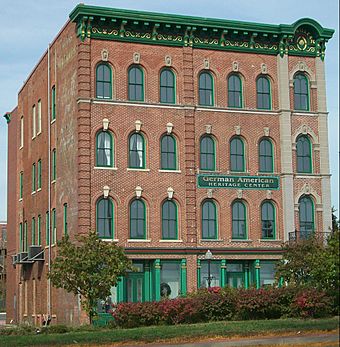German American Heritage Center facts for kids
|
Germania-Miller/Standard Hotel
|
|
 |
|
| Location | 712 W. 2nd St. Davenport, Iowa |
|---|---|
| Area | 1 acre (0.40 ha) |
| Built | 1871 |
| Architectural style | Late Victorian |
| MPS | Davenport MRA |
| NRHP reference No. | 83002438 |
Quick facts for kids Significant dates |
|
| Added to NRHP | July 07, 1983 |
The German American Heritage Center is a special place in Davenport, Iowa. It's a museum and cultural center. This center helps us learn about and keep alive the history of German-Americans. These are people from Germany who moved to the Midwest region of the United States. The building itself is quite old. It was added to the National Register of Historic Places in 1983.
Contents
A Look at Its History
The German American Heritage Center organization started in 1994. In 1995, they bought an old building called the Standard Hotel. This building has a long and interesting past.
Early Days as a Guest House
The building was first built by John Brus. It opened in 1862 as the Germania House. This was a gasthaus, which means a guest house. It was a place where immigrants could stay.
New Owners and New Names
In 1876, John Frederick Miller bought the building. He was a German immigrant too. He had been a manufacturer in Davenport since the 1850s. Miller changed the name to the Miller Hotel. He also ran the restaurant, a billiard room, and a saloon inside the hotel. This continued until 1889. Farmers from Scott County often stayed at the hotel when they visited Davenport.
Changes Through the Years
The hotel's name changed several times in the 1900s. Around 1906, it became the Arcade Hotel. Then, around 1917, it was known as the Henry Blessing Boarding House. From 1924 until 1995, it was called the Standard Hotel. Different shops and businesses used the main floor space over the years.
Becoming a Historic Landmark
The building was recognized for its importance in 1983. It was placed on the National Register of Historic Places. Later, in 1996, it was also added to the Davenport Register of Historic Properties. In 2009, the center had major updates. They added new multimedia displays and improved the exhibit areas.
The Building's Design
The German American Heritage Center is a great example of high Victorian commercial architecture. This style was popular in Davenport.
Special Features
One cool part of the building is its metal cornice. A cornice is a decorative molding that sticks out from the top of a building. John Miller likely added this cornice, as his name is on it. The original storefronts, which are the parts of the building facing the street, had been changed over time. They were carefully restored during the 2009 renovation.
Unique Entrance
The part of the building furthest to the east is special. This is where the hotel's main entrance used to be. It has more decorations than the other six sections. It also sits right below a fancy arch in the cornice.



